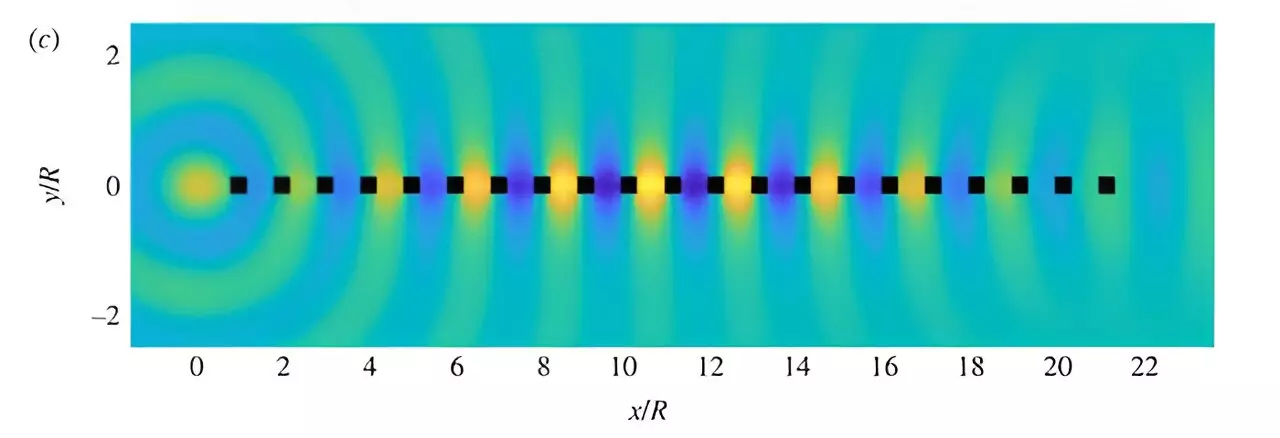The realm of metamaterials—artificial substances engineered to interact with light, sound, and other waves—has taken a significant leap forward thanks to groundbreaking research from Macquarie University. By developing a new software package called TMATSOLVER, researchers have unveiled a powerful tool that can proficiently model how various types of waves scatter upon interacting with complex particle configurations. This innovation not only paves the way for enhanced metamaterial design but also promises to accelerate advancements in various fields, from telecommunications to energy conservation.
At its core, TMATSOLVER leverages the transition matrix, or T-matrix, a crucial mathematical construct that details how specific objects scatter waves. While the T-matrix concept has been around since the 1960s, the recent advancements allow it to be computed with unprecedented accuracy, especially for particles that are larger than the wavelengths being manipulated. This is particularly crucial for metamaterials, where precision and understanding of wave interactions at microscopic scales can lead to groundbreaking applications. Lead researcher Dr. Stuart Hawkins emphasized the leap in capabilities provided by TMATSOLVER, enabling simulations involving hundreds of scatterers, regardless of their geometric complexity.
The success of TMATSOLVER is largely attributed to the collaborative efforts of mathematicians from diverse institutions. This international team, encompassing partners from renowned universities in Australia, the UK, and Germany, showcased the power of cross-disciplinary and cross-border collaboration in tackling intricate scientific challenges. Dr. Luke Bennetts from the University of Adelaide shared insights about the benefits of integrating TMATSOLVER into metamaterial research, noting that it alleviated traditional computational bottlenecks and enabled researchers to explore more intricate geometries without losing valuable time.
The researchers didn’t just stop at developing TMATSOLVER; they demonstrated its capabilities through practical examples that highlighted its versatility. They tackled four case studies focused on metamaterial design, investigating diverse scenarios such as arrangements of anisotropic particles and high-contrast square particles, as well as tunable periodic structures that could manipulate wave dynamics effectively. As these experiments illustrate, the ability to simulate intricate particle configurations holds the potential to reshape our understanding of how metamaterials can be optimized for specific applications.
The implications of this research extend far beyond the laboratory; they touch on the very fabric of materials science and engineering. By enabling rapid prototyping and precise iteration of metamaterial designs, TMATSOLVER could facilitate the creation of technologies like superlenses that render objects invisible at the molecular scale, or soundproofing materials that provide near-perfect noise reduction. The versatility of metamaterials could also be harnessed for energy harvesting devices that maximize efficiency by perfectly absorbing specific wave frequencies.
The TMATSOLVER tool signifies a critical advance in the burgeoning field of metamaterials, which holds much promise in the global marketplace, poised to encounter increasing demand. As industries search for innovative ways to control waves and improve material performance, the research team’s findings and the software’s capabilities establish a foundation for ongoing exploration. Dr. Hawkins has assured that TMATSOLVER can effectively compute the T-matrix for a vast array of particle types, further streamlining the design and validation processes in metamaterial research.
The research output from Macquarie University can be viewed as a paradigm shift in how scientists and engineers approach metamaterial design. Professor Lucy Marshall, Executive Dean of the Faculty of Science and Engineering at Macquarie University, encapsulated the impact of this work, highlighting how computational advancements can fuel innovations in material sciences. With TMATSOLVER empowering researchers to explore the frontiers of metamaterials, we may soon witness a wave of new technologies that redefine our interaction with waves in everyday life. Whether in enhancing energy efficiency, improving telecommunications, or pushing the boundaries of visual technology, the significance of the TMATSOLVER initiative is undeniable.


Leave a Reply
You must be logged in to post a comment.